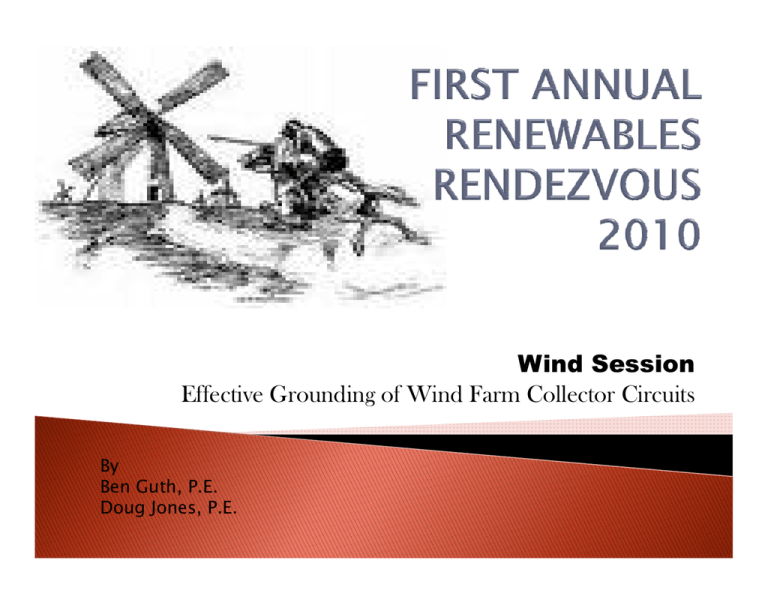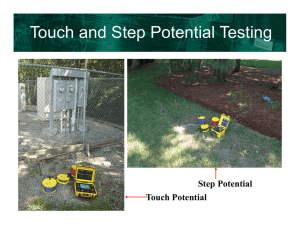Wind Session Effective Grounding of Wind Farm Collector Circuits
advertisement

Wind Session Effective Grounding of Wind Farm Collector Circuits By B G Ben Guth, th P.E. PE Doug Jones, P.E. ` ` ` ` ` What is transient overvoltage (TOV)? What is the cause of TOV? O How is TOV mitigated? Do all types of WTGs have problems with TOV? A dd And do all ll mitigation ii i techniques h i work k ffor all ll types?? How is TOV mitigating equipment specified? ` g an economical g g system y Must design grounding that: ◦ controls TOV to acceptable levels ◦ limits fault current while enabling secure ground fault p protection ` ` ` Transient Overvoltages (TOV) can lead to surge arrester and other equipment failure G Grounding di ttransformers f or high hi h speed d grounding di switches usually provide adequate mitigation Different wind turbine types yp can mean different grounding methods Transformer 69/92/115 MVA 230 kV 34.5 kV 34.5 kV Main Bus 52CAP DVAR 52F1 Collector 1 52F2 52F3 Collector Collector 2 3 52F4 Collector 4 ` Typically 34.5kV ` Approximately 30MVA per circuit ` ` ` Underground cabling for circuits tend to be highly capacitive MOV type yp surge g arrestors installed at each end of the cable system Pad mount or nacelle mounted generator step up ttransformers f (GSU) ◦ (35kV) solidly GndY primary – (1kV-480V) solidly GndY secondary (1kV-480V) 480V) solidly GndY secondary ◦ (35kV) Delta primary – (1kV ` ` ` ` yp 1 – squirrel-cage q g induction g Type generators Type 2 – wound rotor induction generator with controlled t ll d rotor t resistance i t Type 3 – doubly fed generator commonly called a doubly-fed induction generator Type 4 – generator interfaced to the grid totally through a variable speed power electronic drive y system. ` T i l ffault l contribution ib i Typical range off 4 to 9 per unit ` Typical fault contribution range of 4 to 9 per unit ` ` Typical fault contribution less than 2 per unit for remote faults before crowbar Aft crowbar After b engages it resembles bl a Type T 2 ` ` Typical T i l ffault l contribution ib i iis very llow and d dependant upon pre-fault loading Usually Type 3 and 4 WTG short circuit current contributions don’t matter that much and can be complicated to determine exactly ` Ground fault ` Inadvertent opening of circuit during generation ` Capacitor p bank switching g ` Collection cable capacitance ` ` ` ` Ground reference primarily derived by Substation transformer f Circuit disconnects from Substation during a ground fault Overvoltage of non-fault phases depends on grounding/generator type A new ground reference must be derived from circuit to be “effectively grounded” ` Very small “Neutral to Ground Impedance” 100 [kV] 75 50 25 0 -25 -50 -75 -100 0 00 0.00 0 05 0.05 (file Cable.pl4; x-var t) v:G5NCA -X0004A 0 10 0.10 v:G5NCB -X0004B 0 15 0.15 v:G5NCC -X0004C 0 20 0.20 0 25 0.25 0 30 0.30 [s] 0 35 0.35 ` Neutral potential & ground potential are coupled only l by b the h line-to-ground li d capacitances: i A A-Gnd Fault on Ungrounded System Gnd = 0 V VL-G = 1 p.u. A N C VL-G ≈ VL-L = 1.73 1 73 p.u. B Un-faulted System N C B 100 [kV] 75 50 25 0 -25 -50 -75 -100 0 00 0.00 0 05 0.05 (file Cable.pl4; x-var t) v:NGNCA -X0070A 0 10 0.10 v:NGNCB -X0070B 0 15 0.15 v:NGNCC -X0070C 0 20 0.20 0 25 0.25 0 30 0.30 [s] 0 35 0.35 Definition of “Effectively Grounded” ` Effectively grounded when the “coefficient of grounding” (COG) is less than 80% ` COG = VLG/VLL ` Effectively grounded: VLG < 80% of VLL ` If nominal i l VLL iis 34 5 kV f lt d phases h 34.5 kV, th the un-faulted must be VLG < 27.6 kV ` ` ` An effectively grounded system can be approximated i d when h system: ◦ X0 & X1 are both are inductive ◦ X0/X1 ≤ 3 ◦ R0/X1 < 1 To obtain effective ground either reduce R0 & X0, or increase X1 Increase X1 = Increase Load Losses ` Install high speed ground switch ◦ Requires very fast switching, < 1 cycle f h l ◦ Mechanical interlocks do the job well x Currently only one manufacturer ◦ Electric interlocks have not proven reliable, fast enough ` Install grounding transformer ◦ Specifications – needs study ` Wye-Delta or Zig-Zag ◦ Equally effective for limiting TOV ◦ Zig-Zag will be physically smaller but are specialty built transformers available from a limited number of manufacturers with generally long lead times and high pricing due to one-off design ◦ Wye-Delta available – pad-mount type are readily available from multiple manufacturers ` ` ` ` ` ` ` Primary Voltage Rated KVA (if needed) Continuous Neutral Current – Continuous “nontripping” current due to unbalance of the system. tripping system Neutral Fault current and duration Impedance Primary winding connection Secondary connection ` Ohms per phase ◦ Requires study/calculation ` Rated time ◦ 10 second, 1 minute, 10 minute, or extended (less then 90 days/year) ◦ Generally a 10 second rating for a WPP with an “effectively grounded system” due to fast and sensitive protection equ e e ts requirements ` Continuous rated current ◦ Based on rated time (IEEE 32) ◦ 10 second rating = 3% continuous current ◦ Example: 3500 amps for 10 sec = 3500 * 0.03 =105 amps continuous ` ` ` ` ` ` ` ` Model the system Choose some typical (2000kVA, +/-7.5%, Ch t i l parameters t (2000kVA 5.75% 5 75% +/ 7 5% use 6.2%) Simulate ground fault D Determine i VLG-unfaulted < 0.8 0 8 * VLL (less (l than h 27.6 27 6 kV) Modify transformer parameters as needed, repeat Once you’ve reached desired performance, calculate: ◦ ohms per phase ◦ Maximum fault current from grounding transformer One size does not fit all – must consider the system y Check with transformer manufacturer to ensure buildability/availability ` ` ` It’s a “good idea” to limit TOV due to ground faults, and transients due d reduce d i d to WTG, WTG resonance, etc. Debate if the COG method is valid for a asynchronous system Must verify surge arresters, cables, and other equipment will withstand the TOV during ground fault for expected fault duration ` ` For Type 1 & 2 WTGs grounding transformers and fast ground switch breakers are both effective in mitigating TOV TOV results whether the step-up transformers are connected Δ/Yg or Yg/Yg ◦ Generators are ungrounded, therefore do not provide zero sequence fault current ` Ensure the generator will trip off quickly if the substation breaker opens inadvertently ` ` ` ` g transformers and g Both g grounding ground switch breakers can be effective in mitigating TOV Ground switch breaker may y be the p preferred option p as it forces the crowbar to engage and doesn’t require a full transient analysis Transient analysis may be needed Transient analysis adds design time, costs and complexity ` ` ` Type 4 machines should have low fault current contributions to a SLG fault ib i f l Verify fault current contribution from WTG manufacturer For SLG faults on the system the Type 4 power electronic controller switches out very quickly thereby not sourcing voltage to a SLG fault. As a result no significant energy is provided that would create TOV Questions ` ` ` ` ` ` ` ` ` Chong Han, Don E. Martin, Member, IEEE, and Modesto R. lezama, “Transient Over-Voltage (TOV) and Its Suppression For a Large Farm interconnection”. Eaton Application White Paper, “Transient Over voltages on Ungrounded Systems from Intermittent Ground Faults. Pacific Crest Transformers Article, “Grounding Transformers” April, 02 2009. Steven W St W. S Saylors, l P P.E., E ”L ”Large Wi Wind d Pl Plantt C Collector ll t D Design i ”Wi ”Wind dF Farm C Collector ll t S System t G Grounding, di IEEE PES Transmission and Distribution Conference 2008. Mike Reichard, “Fault Current Contributions From Variable Speed (Type 3 and 4) Wind Turbine Generators” Texas A&M Protective Relaying Conference Fault Current Contributions from Wind Plants April p 1,, 2009. ANSI/IEEE Std 32-1972 IEEE Standard Requirements, Terminology, and Test Procedures for Neutral Grounding Devices. Reigh A. Walling, Michael L. Reichard, “Short Circuit Behavior of Wind Turbine Generators” EMA VDH/GSMI brochure (Combined 34.5 kV Vacuum Circuit Breaker & Mechanically Interlocked), available online at: http://www.ema-sa.com.ar IEEE Standard C62.22-1997, Guide for the Application of Metal-Oxide Surge Arresters for AlternatingCurrent Systems.


